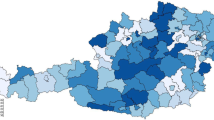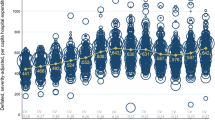Abstract
Since the Stockholm County Council introduced a system of purchasers and providers there has been a quest for population-based resource allocation models to allocate monies to purchasers of health care. In contrast to models used in Britain, Swedish models have been based on individual level data. This paper presents recent developments in the model used in Stockholm for all care except primary care, testing new statistical methods for compression and clustering of the matrices used and the effect of introducing diagnostic information in addition to the demographic and socio-economic information used before. We also show the effect of using more current data sources by replacing existing census variables with data from annually updated registers. Since the aim is to use the resource allocation models for prospective budgeting we test and evaluate the predictive power of the models one to two years ahead. Moreover, two calibration methods are compared: Cross-sectional modelling, based on data for one year only, versus prospective modelling, using population characteristics for one year and registered health-care costs for a following year. While models including diagnostic information are deemed valuable, the prospective models yield little improvement. Further, although it takes a combination of new variables to replace the census based model, the resulting model now implemented by Stockholm County Council has fewer estimated parameters.
Similar content being viewed by others
References
F. Diderichsen, E. Varde and M. Whitehead, Resource allocation to health authorities: the quest for an equitable formula in Britain and Sweden, British Medical Journal 315 (1997) 875–878.
Inregia AB, Stockholm, Consultancy, MCC computer program: R&D version available, documentation in Swedish (1997).
P. Martin-Löf, The notion of redundancy and its use as a quantitative measure of discrepancy between a statistical hypothesis and a set of observational data, Scandinavian Journal of Statistics 1 (1974) 3–18.
Ministry of Health and Social Affairs, HSU 2000: Behov och resurser i vården - en analys (Need and resources in health care - an analysis), SOU 163 (1996).
Ministry of the Interior, Kostnadsutjämning för kommuner och landsting - en översyn av statsbidrags-och utjämningssystemet (Cost compensation for municipalities and county councils - a revision of the governmental subsidy and transfer system), SOU 151 (1998).
SCB Statistics Sweden, Örebro/Stockholm, Register documentation (1998).
Stockholm County Council, Årsredovisning 1998 (The accounts for 1998) (1999).
M. Whitehead et al., As the health divide widens in Sweden and Britain, what is happening to access to care?, British Medical Journal 315 (1997) 1006–1009.
Author information
Authors and Affiliations
Rights and permissions
About this article
Cite this article
Andersson, PÅ., Varde, E. & Diderichsen, F. Modelling of resource allocation to health care authorities in Stockholm County. Health Care Management Science 3, 141–149 (2000). https://doi.org/10.1023/A:1019045408441
Issue Date:
DOI: https://doi.org/10.1023/A:1019045408441




